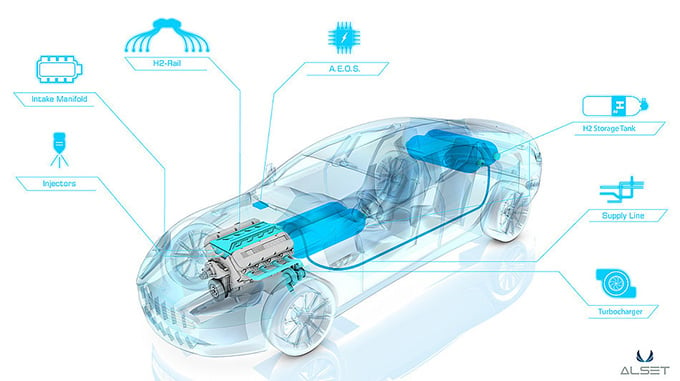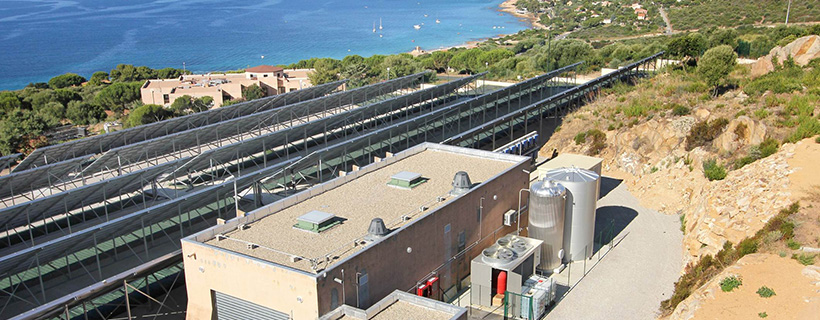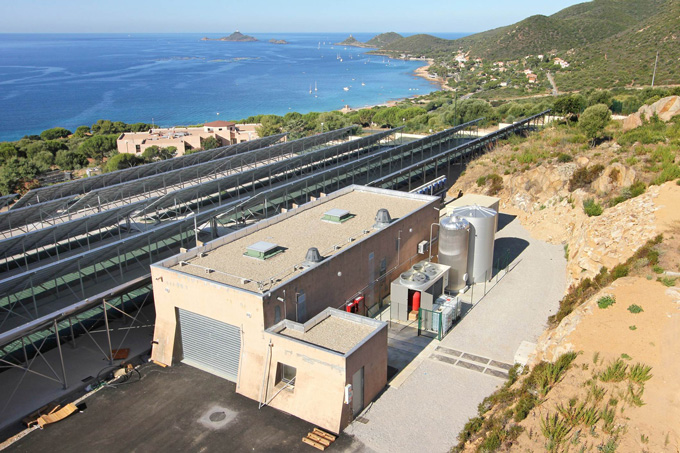In the now 7th part of our series about solar energy storage technologies we will discuss about another technology for chemical storage of energy that enjoys great attention by researchers and governments worldwide: hydrogen storage.
We will look at the specific characteristics of hydrogen, how it works as storage, its advantages and disadvantages, and how a solar system setup with hydrogen storage can be structured.
What is hydrogen?
Hydrogen (H) is the lightest and most abundant chemical element known to mankind. Being a highly reactive monoatomic element, hydrogen forms covalent bonds with most gaseous, liquid, and solid elements of the periodic table, such as oxygen, bromine, and carbon.
The main characteristics of gaseous hydrogen (H2) at standard temperature and pressure (STP) conditions – that is 0° C and 1 bar pressure – are its non-toxic, colorless and odorless properties.
Hydrogen gas is also highly combustible at wide concentration ranges, explosively mixing with many non-metallic elements and its chemical compounds, such as air.
On Earth, most hydrogen exists in the molecular form of water (H2O) and thus poses a non-scarce, recoverable resource. Hydrogen can be separated from its bond with oxygen through electrolysis.
Electrolysis basically involves the conducting of direct current (DC) electricity via two electrodes through an electrolyte which triggers a chemical reaction that separates water into hydrogen and oxygen.
Since its highly reactive, the hydrogen produced through electrolysis is then compressed, liquefied and cooled or otherwise treated and can then be used for hydrogen storage applications.
Hydrogen is an attractive energy carrier as it has a much higher storage energy density per mass than other known fuels, and even better: it can be easily produced using one of the most abundant resources on earth: water.

Storage trend in automobility: Aston Martin with hydrogen storage (Photo courtesy: Alset Hydrogen Mobility)
How does hydrogen storage work?
Hydrogen can be used as a medium for electrical power storage, however, as already mentioned it overwhelmingly exists in molecular form. Therefore, it must first be produced via electrolysis using an electrolyzer.
This effectively involves additional, costly equipment and input energy to power that equipment.
Being subject to lots of research and development, there is no single absolute technology of hydrogen storage but manifold. Scientists and companies worldwide have come up with various solutions for energy storage via hydrogen for later use.
Apart from a few established technologies of hydrogen storage, there are even many more proposals and concepts undergoing research – so many that it would go beyond the scope of this article.
The majority of that ongoing hydrogen storage research concerns mobile applications, particularly in the automotive industry, which in the long-run also have the potential to be used with larger solar mobile applications, such as solar cars or floating solar vehicles.
However, there are also field-proven stationary hydrogen storage technologies that – given the current industry and market structure – are well suited for the storage of intermittent energy sources such as solar energy. The three main technologies are:
Compressed Hydrogen Storage
Compressed hydrogen storage, abbreviated as CH2 Storage, refers to the storing of gaseous hydrogen under a pressure of several hundred bars in hydrogen tanks.
The required storage pressure depends on the material type of the tank used. Apart from high-pressure tanks, such as aluminum and steel-made metal tanks or tanks made from a composite material that withstands several hundred bars of storage pressure, there are also low-pressure tanks available.
Similar to Compressed Air Energy Systems (CAES), compressed gaseous hydrogen can be stored undergrounds in depleted mines, gas fields, or caverns.
This underground hydrogen storage is suitable as grid energy storage for intermittent renewables such as solar energy.
Liquid Hydrogen Storage
Liquid hydrogen storage is another technology that offers higher energy density than compressed hydrogen. The hydrogen is first produced via electrolysis and then brought into liquid form.
To become fully liquid, the hydrogen must be cooled below its boiling point at -253°C, which is achieved by using a special compressor.
The liquid hydrogen must then be cryogenically stored in well isolated, special tanks or underground facilities for later use. The stored liquefied hydrogen basically serves as a fuel in a combustion engine to power connected loads.
Liquefied hydrogen is prominently applied in space applications, such as rocket fuel.
Solid Hydrogen Storage
A third method is to store the hydrogen as solid. Solid hydrogen storage is achieved by the absorption of hydrogen with metals or other chemical compounds.
Metal hydride storage tanks are a specific low-pressure solution requiring only 10 bars. Metal hydride hydrogen storage employs Magnesium or Sodium Aluminum that absorbs the hydrogen as Magnesium Hydride or Sodium Aluminum Hydride.
While the hydrogen absorption – the charging process – creates heat, during discharge, hydrogen is separated from the hydride when heated.
Below is a tabular overview of the current technology research status of the various hydrogen storage technologies in terms of weight and volume and their current costs.
| Hydrogen Storage Technology | Weight (kwh/ kg) | Volume (kwh/ L) | Cost ($/kwh) |
| Solid Hydrogen (Chemical Hydrides) | 1.6 | 1.4 | 8.0 |
| Solid Hydrogen (Metal Hydrides) | 0.8 | 0.6 | 16.0 |
| Liquid Hydrogen | 2.0 | 1.6 | 6.0 |
| Compressed Hydrogen | 1.9 | 1.3 | 16.0 |
Status and costs of different hydrogen storage technologies (table credit: Florida Solar Energy Center)
Solar Photovoltaic Hydrogen Storage
Hydrogen storage in conjunction with solar energy brings an abundant, clean source of (nuclear) energy – the sun – together with an abundant, clean energy carrier source – water.
Solar photovoltaic hydrogen storage itself offers promising opportunities toward a clean cycle of green energy production and storage.
How does such a hydrogen storage cycle work?
To achieve a regenerative and clean cycle, the setup of a sample solar PV compressed hydrogen storage system involves the following components and structures:
- solar photovoltaic array
- water pump
- water storage tanks or basins (if using ocean water then desalination machinery would come in handy)
- electrolyzer
- hydrogen compressor
- hydrogen storage tank
- oxygen storage tank
- fuel cell
The solar photovoltaic array converts incoming sunlight into direct current electricity and not only powers the electrolyzer, but also the water pump that pumps the water from a basin or water storage tank into the electrolyzer.
Following the decomposition of the pumped water into hydrogen and oxygen, both split elements are stored in a hydrogen tank and an oxygen tank respectively.
Once the power needs to be fed back to power loads, for example in the evening when there is no sunshine, then the hydrogen and oxygen are pumped from their respective tanks into a fuel cell.
In the hydrogen-oxygen fuel cell, the hydrogen is channeled to the anode of the fuel cell while the oxygen is channeled to the cathode. The metal electrodes are coated with catalysts such as platinum which trigger the hydrogen to split into positively charge hydrogen ions (protons) and electrons.
The protons pass through a semi-permeable electrolyte membrane while the electrons run along a circuit to the cathode, producing an electric current.
This is then fed back to a connected grid or a load. Then, the electrons together with the protons react with the oxygen at the cathode, producing water. This water can then be pumped back to a water storage tank or – further refined – used as drinking water for irrigation.
As seen in the above project image, it makes sense to locate such systems near a large water source, such as seashores so to use the abundant ocean water resources. The photovoltaic array can also power a connected desalination machine to produce clean fresh water and salt as useful byproducts.
Potentials and Challenges
The advantages and potentials of solar photovoltaic cum hydrogen storage systems are obvious: an environmental-friendly cycle of production, storage, and supply of clean energy can be achieved with the setup of such systems, which can be installed anywhere in the world as long as there is water and sun.
However, there are still many complex challenges ahead.
One major problem is the high cost of setting up such systems and in conjunction with this the high pressure and temperature necessary for compression or liquefaction which require a lot of energy.
The processes of water electrolysis, and the compression or liquefaction of the hydrogen and its re-conversion into electricity also comes with substantial energy losses that drive down the efficiency of such systems.
Moreover, the threat of temperature or pressure changes poses substantial safety risks as hydrogen and oxygen leaking from the storage tanks could literally blow up the whole system.
Potential leakage problems and temperature and pressure changes are geared to the quality and stability of the storage material. Hydrogen diffuses very easily and therefore the tank casing must be materially stable and of high quality.
Low-quality steel for example as a component material for the casing of a compressed hydrogen tank may be a dangerous trigger for such changes and safety risks.
Cost-wise, the low volumetric energy density under normal ambient conditions drive up the storage costs: if space is a constraint, the hydrogen must be stored at high pressure or low temperatures, thus driving up the costs of the required equipment and to power them. If there is an abundance of space, then larger tanks must be built which are expensive as well.
TO OUR READERS:
Do you consider hydrogen a realistic future solar energy storage technology for mainstream system applications such as PV off-grid systems, given the challenges and (currently) prohibitive costs? Share your opinion with the Sinovoltaics Community.








Matt Carrell
on 27 Sep 2015